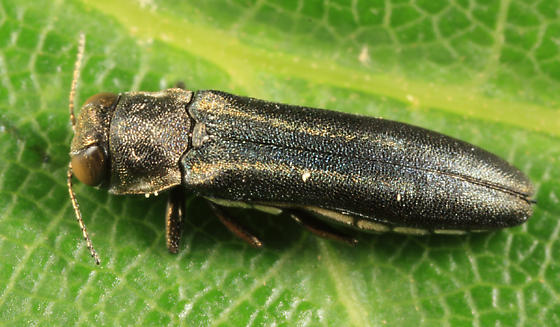Introduction
Two-lined chestnut borer (Agrilus bilineatus) is a beetle that is native to North America. It is a member of the beetle family Buprestidae. Two-lined chestnut borer was once considered the principal pest of American chestnut. It is now considered a major pest of oak trees. The insect is drawn primarily to stressed trees, where it feeds on the host’s phloem, cambium, and xylem. This causes the tree to decline. Severe infestations often culminate in tree mortality.
Distribution & Habitat
In Canada, two-lined chestnut borer extends across the Maritime Provinces. In the United States, the insect ranges from the Northeast states to the Rocky Mountains, and south to Florida and Texas.
Hosts
American chestnut was once the primary host for two-lined chestnut borer. The insect now commonly infests oak trees. Some of the more frequently attacked species include white oak, scarlet oak, northern pin oak, bur oak, chestnut oak, northern red oak, post oak, black oak, and live oak. The adult beetles are attracted to oaks that are declining, or suffering from environmental stress. Urban oaks that undergo stress due to trunk or root injuries, soil compaction, and changes in soil depth are also vulnerable to infestation. Oaks that have been defoliated by insects such as gypsy moth, elm spanworm, fall cankerworm, and forest tent caterpillar are often infested.
Description
The larvae have large, flat heads, and white, slender bodies. Their bodies are segmented, with two distinct spines at the tip of the abdomen, and two to three enlarged segments on the thorax. Due to their flattened appearance, the larvae are often called flat-headed wood borers. Adults are slender, flat-headed black beetles. Adults are easily distinguished by the pair of gold lines spanning the length of their back.
Life Cycle
Two-lined chestnut borer produces one generation per year. Adults overwinter within the host, and emerge from April to August, depending on the geographic location. In the Lake States, they appear from late May to early June. As they depart from the tree, the adults bore characteristic d-shaped exit holes about 1/5 of an inch wide in the bark. These visible d-shaped exit holes indicate that a section of the oak tree was infested, and is now likely dead. In many instances, other bark and wood boring insects will colonize the portions of the crown and trunk that have been killed by two-lined chestnut borer.
Upon emerging, the adults begin feeding on nearby foliage. They mature shortly thereafter. The adults navigate to the host’s branches and trunk to mate. Soon after mating, the females lay small clusters of eggs in the host’s bark cracks, and crevices. The eggs hatch within one to two weeks, revealing masses of tiny larvae. The larvae bore through the outer bark to the inner bark tissue, where they proceed to tunnel in a wandering manner, feeding on the nutritional components of the pheloem, cambium, and xylem all the while. This disrupts the tree’s ability to effectively transport water and nutrients throughout the crown. The larvae feed from June to August, gradually increasing in size. During this period, they progress through four instars. When fully grown, the larvae burrow into the outer bark, and construct chambers in the outer sapwood. The larvae overwinter within these chambers, curling into a doubled-over position. As temperatures warm in spring, the larvae pupate, and emerge as adults. In the cooler parts of the insect’s range, the larvae may require two years to complete their development.
Effects on Trees
Symptoms of infestation become evident in mid-July. The foliage on infested branches turns brown, and wilts prematurely. The wilted foliage will often remain attached to the tree for several weeks or months before being shed. Infested branches often die back, and will be devoid of growth the following year. Severe infestations generally cause the host to decline. In forested settings, or densely wooded residential sites, outbreaks may occur, resulting in pockets of dead and declining trees. Trees may succumb to heavy infestation within the first year. Trees that survive initial infestations generally fail within two to three years. Infested trees are more susceptible to diseases, particularly Armillaria root rot. Armillaria root rot works in conjunction with two-lined chesnut borer to cripple, and disfigure host trees.
Management
- Maintain tree vigor through sound cultural practices. Ensure trees are sufficiently watered, especially during extended periods of drought. Apply a layer of organic mulch around the base of susceptible trees to improve soil quality, moderate soil temperature, and retain soil moisture. Fertilize trees to promote healthy growth.
- Prune and dispose of heavily infested branches in late summer, when they can be easily detected. Pruning cuts should be administered below the last wilted leaves on each branch.
- Avoid subjecting trees to mechanical injuries.
- Larval parasites provide some natural control. One larval parasite, the chalcid wasp Phasgonophora villosus, is highly effective at limiting two-lined chestnut borer populations.
- The downy and hairy woodpeckers Picoides pubescens and Picoides villosus assist in reducing insect populations. They feed primarily on the overwintering larvae.
- Trees with abundant insect populations should be culled to prevent further infestations. Remove infested trees during late summer or early fall, when the larvae are still developing.
- Temporary chemical treatments can be adopted to promote recovery in trees that are undergoing environmental, cultural, or biological stress. These include trunk injections, trunk and foliar sprays, and soil treatments.
- Pesticide treatments may be employed to protect shade and ornamental trees from infestation.The first application should be performed in early spring, one to two weeks before the adults emerge. To ensure success, thoroughly drench the tree’s branches and trunk. Two subsequent applications should be adminstered at two week intervals.
- Infested logs can be treated with pesticides. A single application should be performed on the bark in early spring, one to three weeks prior to the adults’ emergence.
Photo courtesy of Joshua P. Basham/CC-by-1.0


